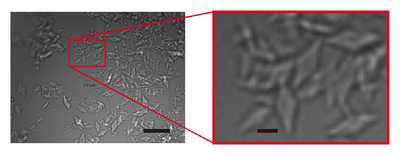Journal:Acta Cryst F:S2053230X21008967
From Proteopedia
(Difference between revisions)

| Line 10: | Line 10: | ||
{{Clear}} | {{Clear}} | ||
Visualization of enzymatic catalysis as molecular movies may be an ultimate goal for enzymologists. However, the direct observation of structural changes associated with the ongoing reaction has been a difficult task until recently. A new method called ‘Serial Femtosecond Crystallography (SFX)’, in which protein microcrystals delivered continuously are irradiated with ultrahigh-intensity X-ray pulses produced from X-ray free-electron lasers (XFELs), is expected to be a clue for achieving such a goal. Because diffraction data can be collected before the crystals suffer from radiation damage, SFX allows the determination of X-ray damage-free structures at room temperature. The femtosecond duration of X-ray pulses is also advantageous for visualizing rapid structural changes associated with protein action. However, preparation of high-quality microcrystals with uniform size has been a bottleneck for widespread application of SFX that consumes plenty of microcrystals. This paper reports a convenient method for production of uniform, high-quality microcrystals by combining micro-seeding and batch methods. The objective protein we used is a quinoprotein metalloenzyme, copper amine oxidase from ''Arthrobacter globiformis'' (AGAO), for which high-resolution X-ray and neutron crystal structures have already been determined at cryogenic temperatures. The first X-ray-damage-free AGAO structure determined at room temperature by SFX (PDB ID: [[7f8k]]) is herein reported. | Visualization of enzymatic catalysis as molecular movies may be an ultimate goal for enzymologists. However, the direct observation of structural changes associated with the ongoing reaction has been a difficult task until recently. A new method called ‘Serial Femtosecond Crystallography (SFX)’, in which protein microcrystals delivered continuously are irradiated with ultrahigh-intensity X-ray pulses produced from X-ray free-electron lasers (XFELs), is expected to be a clue for achieving such a goal. Because diffraction data can be collected before the crystals suffer from radiation damage, SFX allows the determination of X-ray damage-free structures at room temperature. The femtosecond duration of X-ray pulses is also advantageous for visualizing rapid structural changes associated with protein action. However, preparation of high-quality microcrystals with uniform size has been a bottleneck for widespread application of SFX that consumes plenty of microcrystals. This paper reports a convenient method for production of uniform, high-quality microcrystals by combining micro-seeding and batch methods. The objective protein we used is a quinoprotein metalloenzyme, copper amine oxidase from ''Arthrobacter globiformis'' (AGAO), for which high-resolution X-ray and neutron crystal structures have already been determined at cryogenic temperatures. The first X-ray-damage-free AGAO structure determined at room temperature by SFX (PDB ID: [[7f8k]]) is herein reported. | ||
| - | <scene name='89/891404/Cv/3'>The overall structure of AGAO determined by SFX</scene> had almost the same conformation as those determined previously by synchrotron X-ray and neutron crystallography performed at cryogenic temperature. The electron-density map in the active site clearly showed the resting form of the protein-derived cofactor, 2,4,5-trihydroxyphenylalanine quinone (TPQ). In addition, the active-site Cu2+ was ligated with three histidine residues and two water molecules that are located at positions identical to those determined by the previous studies. These results show that the bound Cu2+ in AGAO is resistant to X-ray photoreduction, which is accompanied by conformational changes of the metal coordination structure. The availability of high-quality microcrystals in large quantities is promising for studying the structural changes of AGAO during the catalytic reaction by the ‘mix-and-inject’ time-resolved SFX. | + | <scene name='89/891404/Cv/3'>The overall structure of AGAO determined by SFX</scene> had almost the same conformation as those determined previously by synchrotron X-ray and neutron crystallography performed at cryogenic temperature. AGAO functions as a dimer, but in the crystals obtained in this study, the unit cell contained the monomer of AGAO (shown in a green ribbon model) in the asymmetric unit. The counter subunit forming the dimer is also shown as a royal blue trace model. The electron-density map in the active site clearly showed the resting form of the protein-derived cofactor, 2,4,5-trihydroxyphenylalanine quinone (TPQ). In addition, the active-site Cu2+ was ligated with three histidine residues and two water molecules that are located at positions identical to those determined by the previous studies. These results show that the bound Cu2+ in AGAO is resistant to X-ray photoreduction, which is accompanied by conformational changes of the metal coordination structure. The availability of high-quality microcrystals in large quantities is promising for studying the structural changes of AGAO during the catalytic reaction by the ‘mix-and-inject’ time-resolved SFX. |
<b>References</b><br> | <b>References</b><br> | ||
Revision as of 14:53, 9 September 2021
| |||||||||||
This page complements a publication in scientific journals and is one of the Proteopedia's Interactive 3D Complement pages. For aditional details please see I3DC.

